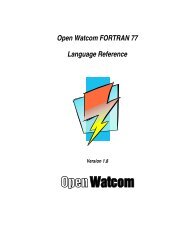Relocatable Object Module Format (OMF) Specification
Relocatable Object Module Format (OMF) Specification
Relocatable Object Module Format (OMF) Specification
You also want an ePaper? Increase the reach of your titles
YUMPU automatically turns print PDFs into web optimized ePapers that Google loves.
<strong>Relocatable</strong> <strong>Object</strong> <strong>Module</strong> <strong>Format</strong><br />
Start Address<br />
The Start Address subfield is present only if the Start bit in the <strong>Module</strong><br />
Type byte is set. Its format is identical to the Fix Data, Frame Datum,<br />
Target Datum, and Target Displacement fields in a FIXUP subrecord<br />
of a FIXUPP record. Bit 2 of the End Data field, which corresponds to<br />
the P bit in a Fix Data field, must be 0. The Target Displacement field<br />
(if present) is a 4-byte field if the record type is 8BH and a 2-byte field<br />
otherwise. This value provides the initial contents of CS:(E)IP.<br />
If overlays are used, the start address must be given in the MODEND<br />
record of the root module.<br />
Notes<br />
A MODEND record can appear only as the last record in an object module.<br />
It is assumed that the Link Pass Separator comment record (COMENT A2, subtype 01) will not be<br />
present in a module whose MODEND record contains a program starting address. If there are<br />
overlays, the linker needs to see the starting address on Pass 1 to define the symbol $$MAIN.<br />
Example<br />
Consider the MODEND record of a simple HELLO.ASM program:<br />
0 1 2 3 4 5 6 7 8 9 A B C D E F<br />
0000 8A 07 00 C1 00 01 01 00 00 AC.....<br />
Byte 00H contains 8AH, indicating a MODEND record.<br />
Bytes 01-02H contain 0007H, the length of the remainder of the record.<br />
Byte 03H contains 0C1H (11000001B). Bit 7 is set to 1, indicating that this module is the main module of the<br />
program. Bit 6 is set to 1, indicating that a Start Address subfield is present. Bit 0 is set to 1, indicating that the<br />
address referenced in the Start Address subfield must be fixed up by the linker.<br />
Byte 04H (End Data in the Start Address subfield) contains 00H. As in a FIXUPP record, bit 7 indicates that the<br />
frame for this fixup is specified explicitly, and bits 6 through 4 indicate that a SEGDEF index specifies the frame.<br />
Bit 3 indicates that the target reference is also specified explicitly, and bits 2 through 0 indicate that a SEGDEF<br />
index also specifies the target.<br />
Byte 05H (Frame Datum in the Start Address subfield) contains 01H. This is a reference to the first SEGDEF<br />
record in the module, which in this example corresponds to the _TEXT segment. This reference tells the linker that<br />
the start address lies in the _TEXT segment of the module.<br />
Byte 06H (Target Datum in the Start Address subfield) contains 01H. This also is a reference to the first SEGDEF<br />
record in the object module, which corresponds to the _TEXT segment. For example, Microsoft LINK uses the<br />
following Target Displacement field to determine where in the _TEXT segment the address lies.<br />
Bytes 07-08H (Target Displacement in the Start Address subfield) contain 0000H. This is the offset (in bytes) of<br />
the start address.<br />
Byte 09H contains the Checksum field, 0ACH.<br />
Tool Interface Standards (TIS) <strong>OMF</strong> <strong>Specification</strong>, Version 1.1 27
















